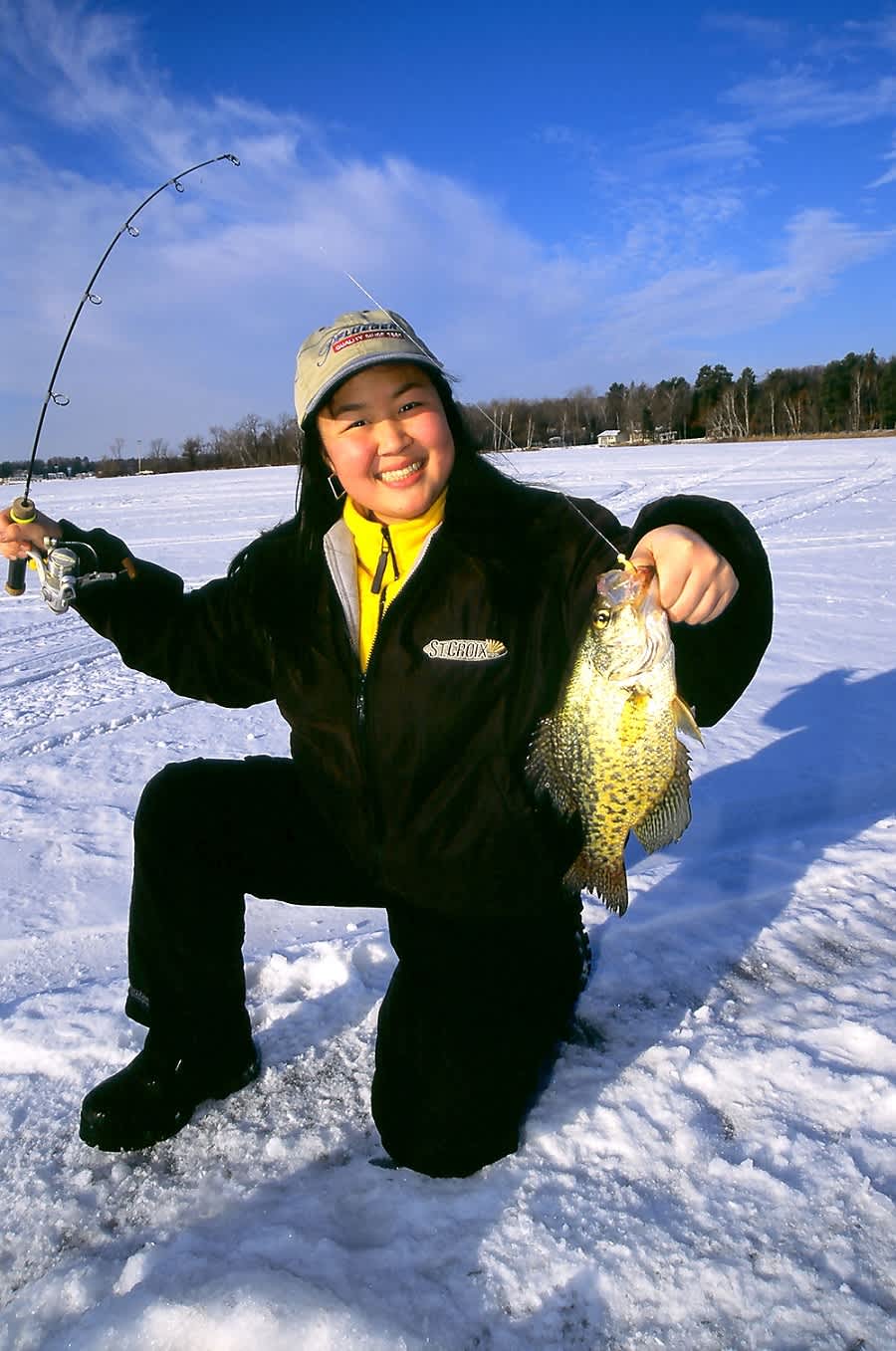Glow-in-the-dark Ice Fishing
Ted Takasaki 12.04.13

There are many bright ideas for fishing hard water, but there’s one that has been pretty consistent over the years: the use of glow colors for low-visibility conditions. Fishing at night or in low-light conditions (sunrise, sundown, or in stained or dirty water) often creates special problems for ice anglers. Fish can have difficulty “eating your bait” if they can’t see it.
Having said that, it’s known that many predator fish have the ability to locate prey using their lateral line sense. Given the option, though, fish appear to prefer to use sight to nail down something to eat. With some species that ice anglers love to target, such as bluegills and pike, they darn near have to see your bait or you go biteless!
Recent breakthroughs in paint technology have allowed manufacturers to paint jigs in a variety of glowing colors, like blue, red, and chartreuse. Different colors emit light at different intensities under different conditions. Sometimes, one color may overpower fish. Another color may not be enough to draw them near. Always experiment and let the fish tell you what they want.
Light of day
Glow jigs shine even in daytime and will often catch walleyes and panfish when nothing else works. Why? Maybe it’s because you’re fishing at sunrise or sunset. But, many lakes in the North are fed by streams that flow through cedar swamps. Water is stained like tea by tannic acid. Visibility is diminished even at midday, especially when the ice thickens and snow covers the ice, cutting down on light penetration.
When that’s the case, fish often go deeper as winter settles in. They are forced out of the shallows when weeds die and sap oxygen from their surroundings. Baitfish will suspend somewhere between top and bottom, looking for the depth where plankton reside, and predators have a harder time finding them. A glow jig will attract fish that settle at the same depth as the baitfish. Then, the action you put on your jig will make them bite.
Stained lakes normally offer classic structure situations. For walleyes, you usually can’t go wrong fishing over hard bottoms on the steepest drops to the deepest part of the lake. Use a lake map and your GPS armed with a LakeMaster mapping chip to search out potential spots. Drill multiple holes and use a portable depth finder, like a Humminbird ICE597 to search for fish. The ICE 597 has a GPS and a graph all built into one unit for convenience.
Later in winter, move to deeper structure like mid-lake humps. As ice-out nears, concentrate on spots near known spawning areas.
Start by jigging aggressively with minnows to prompt a reaction strike from the most active fish. Hook the minnow through the mouth and up through the head. You can also clip the head of the minnow just behinds the gills.
Small lakes may host spectacular prospects for panfish, like bluegills, crappies, and perch. Head to the deepest area of the lake and remember that “deep” is relative. Seek that area out whether it’s 40 feet or 20 feet.
On large lakes, look for deep areas in bays and inside turns on points at the mouths of bays that reach to deep water.
Smaller vertical jigs and spoons tipped with Euro Larvae work best for panfish. Use a sensitive ice-stick, like the St. Croix Legend Ice series rods that let you keep in touch with your bait. Jiggle it constantly with short movements so the jig vibrates. This action triggers attention.
Perch tend to hold deeper in schools as big as a football field. When fishing with friends, leap-frog each other in order to drill holes at 100-foot intervals until someone connects. Try a small, red glow #8 jig tipped with Euro Larvae. Drop it to the bottom and slightly raise it, and twitch. Fish may be finicky during the day. Try to stay away from the crowd.
Sunlight is a good way to make phosphorescent paint glow. Some anglers like to use camera flash units. However, it often seems that the batteries are drained when you need them most, either through overuse or failure to turn the flash unit off after you were done the last time. There are now many different small, super-bright, LED flashlights that work much better.
Night bite
The action improves significantly after dark for walleyes and some species of panfish, like crappies. Even larger bluegills will bite after the sun goes down. For this fishing, glow jigs are a must.
As for location, the same spots you fish during daytime will hold walleyes and crappies after dark. Bottom structure that holds baitfish is best for walleyes. Focus on dropoffs near points, on humps or channel edges.
Crappies often suspend over the deepest water in small lakes. In larger lakes, they can be found suspended. Funnel areas between the tips of two points that come close to each other or where a sunken island is located just off a point are good, too.
Fish are not so spooky after dark. Fish with friends or migrate toward the groups.
Other tips
Use the biggest auger you think you’ll need for the species of fish you are going after. The bigger the hole, the easier it will be to retrieve your fish.
If you don’t connect with any fish, don’t stay long. The more you move, the more likely you will locate active schools. Take a friend with you in case you run into trouble. Don’t fish alone. And take your flotation cushion out of your boat and tie 50 feet of rope to it. It can be a lifesaver if one of your group falls through thin ice.
Light up your life with glow jigs through the ice. They’re a real turn-on.

